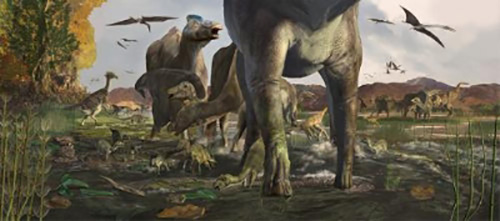
Dinosaur Herds Thrived In Ancient Alaska Ecosystem
July 11, 2014
A trio of paleontologists announced the discovery of a tracksite in Alaska's Denali National Park filled with duck-billed dinosaur footprints that demonstrate the animals lived in multi-generational herds and thrived in the ancient Alaska ecosystem...
It began in 2007, when the trio went on a survey sponsored by the U.S. National Park Service. At that point, the Upper Cretaceous Cantwell Formation in the Alaska Range of Denali had not been explored. On the last day, perched precariously on the steep side of the mountain, Fiorillo said the three men were giddy when they came upon the wealth of tracks. "Without question, Denali is one of the best dinosaur footprint localities in the world, but what we found that last day was incredible – so many tracks, so big, and so well preserved," said Fiorillo. "Many had skin impressions so we could even see what the bottom of their feet looked like. And there were lots of invertebrate traces – the tracks of bugs, worms, larvae and more – which were important to us because they showed an ecosystem existed during the warm parts of the years." Hasiotis adds that the findings told them a lot about how hadrosaurs lived as families within the warmer-than-expected Arctic climate. "The Denali tracksite is extremely significant to the reconstruction of this Cretaceous high latitude polar ecosystem as it demonstrates higher annual temperatures compared to the present-day climate. The hadrosaur tracks show specifically where they lived and how they acted as an extended family," said Hasiotis. "The burrows and trails of mud-loving beetles, mole crickets, midge fly larvae, and other sediment-dwelling beasties demonstrate that the whole cast of characters left their traces of life in the river bank sediments during the warm summer months—frozen in time, waiting to be discovered!" Over the next several years, the three returned to the excavation site again and again. Because the fossils were so well preserved, they were able to accurately measure and analyze the footprints, which showed that four different age classes of Hadrosaurids – adults, sub-adults, juveniles and very young individuals – lived together in a large social group. The team's research also suggests that the Hadrosaurid dinosaurs – affectionately known as the "cows of the Cretaceous" – experienced a period of rapid growth in their life history. "This is one of the greatest dinosaur tracksites in the world in terms of size, number, and quality. We could see how hadrosaurs walked, ran, or slipped on muddy surface. Footprints were so vivid that we almost could see and smell them," said Kobayashi. "We were so excited when we found tiny, baby footprints, because we instantly knew this was the evidence to support the polar hadrosaurs survived through winters and lived as a herd to protect each other like other mammals do."` They initially thought they had five stair-stepped layers of rock on the side of the mountain. In 2009, after a helicopter hovered over the site providing an aerial view, they realized it was instead a single bedding plane – and it was at risk. If an earthquake occurred – as what happened in 2002 when a major earthquake rocked a nearby region of Denali – the extraordinary tracks would crumble and slide down the mountain into a nearby river. Denali National Park officials immediately recognized the potential danger and acted quickly to help the paleontologists remove and preserve the specimens. Fiorillo credits the National Park Service and specifically the staff at Denali National Park stating that "without their cooperation, none of this would have happened." The molds were transported to the Perot Museum of Nature and Science in Dallas to fossil preparator Ronald S. Tykoski, Ph.D., who began meticulously crafting casts of the tracks. They are on permanent display in the Perot Museum's T. Boone Pickens Life Then and Now Hall, located at 2201 N. Field St, Dallas, Texas.
Source of News:
|
||
